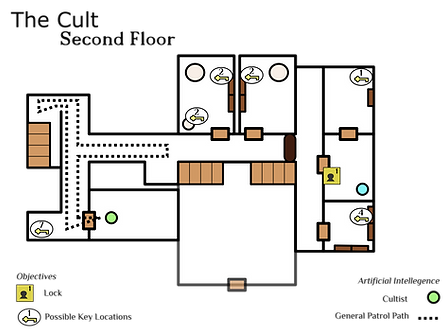Sam Scott
Game Developer
The Cult v- 2018
-
Role: Designer
-
Platform: PC
-
Built in Unreal Engine 4
-
Team of 4
-
12 weeks of development time
Overview
First-person stealth horror game about escaping a mansion crawling with cultists of a dark sect. The player collects keys and maneuvers around corners to eventually escape out of the main door.
My Work
Project Overview
Our main goal was creating a game stealth exploration game, with horror elements that had high replay value. After prototyping 3 different ideas, we decided on moving forward with the idea that later became The Cult.

The first prototype was a mechanical test of what the core gameplay would look like. The player was to collect pieces of evidence while AI cultists roamed, and would chase the player on sight. When the player picked up all pieces of evidence, they won.

The second major prototype took the mechanics we had developed and put them in fitting narrative and visual context. With a more realistic environment, thanks to 3D mansion art assets and moody lighting, another step towards creepy mood and immersion was achieved. The player was now in the seat of an investigator, discovering mysteries and not knowing what was around the next corner...

The third and final prototype had a complete change in game goal and narrative. We wanted to better reflect how players were playing the game: avoiding cultists and grabbing items in desperation. So we remade the level, created a new key-based progression system, and told players that they were escaping the mansion they were in, instead of investigating.
Level Design
Our first level in our prototype was a sample scene made by our programmer to demonstrate the movement of the A.I. in the game. It worked as a proof of concept, but a full level was needed to create immersion and to subtly guide the player and teach game mechanics.
Next, I worked with our artist to develop the level. Something that was really important from the start was the making the level feel like a real living space. We collaborated to create a floor-plan that resembled a real mansion, and marked multiple places where the player could start and potential routes for the AI to path. When we finished iterating, I filled out documentation that represented what the level would eventually be built as.


Balancing and Player Experience
It took many QA testing sessions to learn where players struggled and where they succeeded. After going through responses and feedback, we adjusted the level to give the player more time to grasp the mechanics and feel. For example, we had the player to start in an mostly empty upstairs room, instead of downstairs. Players started on a linear path, with simple things to do like unlocking doors and hiding under clothed tables without fear of being spotted by the cultists, yet.

After the player leaves the first room, the player is unable to move forward, leaving only a key sitting on top of a table in front of them. After picking up the key, the player will notice they can interact with the clothed table to hide under it. Additionally, a cultist roams the halls ahead of the player, letting them know danger is about.

Next, the player is greeted by an open space and an important door, adorned with three locks. This as well as two other locked doors in the room, gives the player time to travel around and guess where their newly acquired key is needed. The secret is that this key matches only one of the 1-lock doors. From there, the player cannot access any more floors, meaning they must explore either back upstairs or through a newly unlocked doors.
This is where the linearity ends. The player has only their own guesses as to where the keys to the three-lock door are. With less of a linear path, the player will naturally feel more tense and scared, having to explore an environment of more unknowns.
Key and Door Mechanics
In the early stages of our game, players had no sense of progression in the game. Running through the level ignoring everything around them was a valid strategy, there was no reason reason to explore the environment or feel that they were being challenged besides the cultists that roamed around. To Fix this, I designed a system of locked door and keys to require the player to pick up differently illuminated keys to progress.
When first making this, I had a tough time deciding what data to attach to a key and a lock to check for when the player tries to unlock a door. Then I had the idea to directly tie the visual feedback in the game with the functionality. I tied the key to its respective door's lock through the color value of a light. When the player tried to open a lock, the game would compare the light value of the door's glow versus each color of key the player had.


To help keep the game feeling fresh and replayable, I added a key spawner system to not only vary the colors of the keys on each playthrough but also randomize the locations of where a key could spawn. Each door lock has a list of potential spawn positions for its related key.
At the beginning of the game, the door lock picks a color and one of the spawn locations from the list to spawn a key. As the level design in the game changed, it was easier to design new rooms with the idea in mind that we could pick multiple places to put the key without having to worry about which specific location to use in the end.
